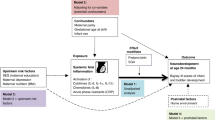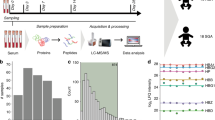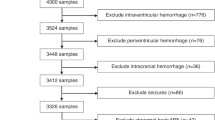Abstract
Background:
We sought to disentangle the contributions of perinatal systemic inflammation and being small for gestational age (SGA) to the occurrence of low Bayley Mental Development Indices (MDIs) at the age of 2 y.
Methods:
We measured the concentration of 25 inflammation-related proteins in blood obtained during the first two postnatal weeks from 805 infants who were born before the 28th wk of gestation and who had MDI measurements at the age of 2 y and were able to walk independently.
Results:
SGA newborns who did not have systemic inflammation (a concentration of an inflammation-related protein in the top quartile for gestational age on two days a week apart) were at a greater risk of an MDI <55, but not 55–69, than their peers who had neither SGA nor systemic inflammation. SGA infants who had elevated blood concentrations of interleukin (IL)-1β, tumor necrosis factor-α, or IL-8 during the first 2 postnatal weeks were at even higher risk of an MDI <55 than their SGA peers without systemic inflammation and their non-SGA peers with systemic inflammation.
Conclusion:
SGA appears to place very preterm newborns at an increased risk of a very low MDI. Systemic inflammation adds considerably to the increased risk.
Similar content being viewed by others
Log in or create a free account to read this content
Gain free access to this article, as well as selected content from this journal and more on nature.com
or
References
Hutcheon JA, Platt RW . The missing data problem in birth weight percentiles and thresholds for “small-for-gestational-age”. Am J Epidemiol 2008;167:786–92.
Padilla N, Falcón C, Sanz-Cortés M, et al. Differential effects of intrauterine growth restriction on brain structure and development in preterm infants: a magnetic resonance imaging study. Brain Res 2011;1382:98–108.
Guellec I, Lapillonne A, Renolleau S, et al.; EPIPAGE Study Group. Neurologic outcomes at school age in very preterm infants born with severe or mild growth restriction. Pediatrics 2011;127:e883–91.
Morsing E, Asard M, Ley D, Stjernqvist K, Marsál K . Cognitive function after intrauterine growth restriction and very preterm birth. Pediatrics 2011;127:e874–82.
Graham EM, Holcroft CJ, Rai KK, Donohue PK, Allen MC . Neonatal cerebral white matter injury in preterm infants is associated with culture positive infections and only rarely with metabolic acidosis. Am J Obstet Gynecol 2004;191:1305–10.
Glass HC, Bonifacio SL, Chau V, et al. Recurrent postnatal infections are associated with progressive white matter injury in premature infants. Pediatrics 2008;122:299–305.
Shah DK, Doyle LW, Anderson PJ, et al. Adverse neurodevelopment in preterm infants with postnatal sepsis or necrotizing enterocolitis is mediated by white matter abnormalities on magnetic resonance imaging at term. J Pediatr 2008;153:170–5, 175.e1.
Martin CR, Dammann O, Allred EN, et al. Neurodevelopment of extremely preterm infants who had necrotizing enterocolitis with or without late bacteremia. J Pediatr 2010;157:751–6.e1.
van der Ree M, Tanis JC, Van Braeckel KN, Bos AF, Roze E . Functional impairments at school age of preterm born children with late-onset sepsis. Early Hum Dev 2011;87:821–6.
Leviton A, Kuban KC, Allred EN, Fichorova RN, O’Shea TM, Paneth N; ELGAN Study Investigators. Early postnatal blood concentrations of inflammation-related proteins and microcephaly two years later in infants born before the 28th post-menstrual week. Early Hum Dev 2011;87:325–30.
Leviton A, Kuban K, O’Shea TM, et al. The relationship between early concentrations of 25 blood proteins and cerebral white matter injury in preterm newborns: the ELGAN study. J Pediatr 2011;158:897–903.e1–5.
O’Shea TM, Allred EN, Kuban KC, et al.; Extremely Low Gestational Age Newborn (ELGAN) Study Investigators. Elevated concentrations of inflammation-related proteins in postnatal blood predict severe developmental delay at 2 years of age in extremely preterm infants. J Pediatr 2012;160:395–401.e4.
Resch B, Neubauer K, Hofer N, et al. Episodes of hypocarbia and early-onset sepsis are risk factors for cystic periventricular leukomalacia in the preterm infant. Early Hum Dev 2012;88:27–31.
Campbell LR, Pang Y, Ojeda NB, Zheng B, Rhodes PG, Alexander BT . Intracerebral lipopolysaccharide induces neuroinflammatory change and augmented brain injury in growth-restricted neonatal rats. Pediatr Res 2012;71:645–52.
Arnold CC, Kramer MS, Hobbs CA, McLean FH, Usher RH . Very low birth weight: a problematic cohort for epidemiologic studies of very small or immature neonates. Am J Epidemiol 1991;134:604–13.
Sackett DL . Bias in analytic research. J Chronic Dis 1979;32:51–63.
Kuban KCK, Allred EN, O’Shea TM, et al. An algorithm for diagnosing and classifying cerebral palsy in young children. J Pediat 2008;153:466–72.e461.
Fichorova RN, Richardson-Harman N, Alfano M, et al. Biological and technical variables affecting immunoassay recovery of cytokines from human serum and simulated vaginal fluid: a multicenter study. Anal Chem 2008;80:4741–51.
Fichorova RN, Onderdonk AB, Yamamoto H, et al.; Extremely Low Gestation Age Newborns (ELGAN) Study Investigators. Maternal microbe-specific modulation of inflammatory response in extremely low-gestational-age newborns. MBio 2011;2:e00280–10.
Hecht JL, Fichorova RN, Tang VF, Allred EN, McElrath TF, Leviton A; Elgan Study Investigators. Relationship Between Neonatal Blood Protein Concentrations and Placenta Histologic Characteristics in Extremely Low GA Newborns. Pediatr Res 2011;69:68–73.
McElrath TF, Fichorova RN, Allred EN, et al.; ELGAN Study Investigators. Blood protein profiles of infants born before 28 weeks differ by pregnancy complication. Am J Obstet Gynecol 2011;204:418.e1–12.
Leviton A, Fichorova R, Yamamoto Y, et al. Inflammation-related proteins in the blood of extremely low gestational age newborns. The contribution of inflammation to the appearance of developmental regulation. Cytokine 2011;53:66–73.
Ramma W, Ahmed A . Is inflammation the cause of pre-eclampsia? Biochem Soc Trans 2011;39:1619–27.
Cemgil Arikan D, Aral M, Coskun A, Ozer A . Plasma IL-4, IL-8, IL-12, interferon-γ and CRP levels in pregnant women with preeclampsia, and their relation with severity of disease and fetal birth weight. J Matern Fetal Neonatal Med 2012;25:1569–73.
Sugimoto J, Romani AM, Valentin-Torres AM, et al. Magnesium decreases inflammatory cytokine production: a novel innate immunomodulatory mechanism. J Immunol 2012;188:6338–46.
Pallotto EK, Kilbride HW . Perinatal outcome and later implications of intrauterine growth restriction. Clin Obstet Gynecol 2006;49:257–69.
Eklind S, Mallard C, Leverin AL, et al. Bacterial endotoxin sensitizes the immature brain to hypoxic–ischaemic injury. Eur J Neurosci 2001;13:1101–6.
Dammann O, Brinkhaus MJ, Bartels DB, et al. Immaturity, perinatal inflammation, and retinopathy of prematurity: a multi-hit hypothesis. Early Hum Dev 2009;85:325–9.
Adén U, Favrais G, Plaisant F, et al. Systemic inflammation sensitizes the neonatal brain to excitotoxicity through a pro-/anti-inflammatory imbalance: key role of TNFalpha pathway and protection by etanercept. Brain Behav Immun 2010;24:747–58.
Williamson LL, Sholar PW, Mistry RS, Smith SH, Bilbo SD . Microglia and memory: modulation by early-life infection. J Neurosci 2011;31:15511–21.
Orman MA, Ierapetritou MG, Berthiaume F, Androulakis IP . The dynamics of the early inflammatory response in double-hit burn and sepsis animal models. Cytokine 2011;56:494–502.
Patten IS, Rana S, Shahul S, et al. Cardiac angiogenic imbalance leads to peripartum cardiomyopathy. Nature 2012;485:333–8.
Joss-Moore LA, Lane RH . The developmental origins of adult disease. Curr Opin Pediatr 2009;21:230–4.
Hagberg H, Gressens P, Mallard C . Inflammation during fetal and neonatal life: implications for neurologic and neuropsychiatric disease in children and adults. Ann Neurol 2012;71:444–57.
Leviton A, Blair E, Dammann O, Allred E . The wealth of information conveyed by gestational age. J Pediatr 2005;146:123–7.
Streimish IG, Ehrenkranz RA, Allred EN, et al.; ELGAN Study Investigators. Birth weight- and fetal weight-growth restriction: impact on neurodevelopment. Early Hum Dev 2012;88:765–71.
O’Shea TM, Allred EN, Dammann O, et al.; ELGAN study Investigators. The ELGAN study of the brain and related disorders in extremely low gestational age newborns. Early Hum Dev 2009;85:719–25.
McElrath TF, Hecht JL, Dammann O, et al.; ELGAN Study Investigators. Pregnancy disorders that lead to delivery before the 28th week of gestation: an epidemiologic approach to classification. Am J Epidemiol 2008;168:980–9.
Bayley N . Bayley Scales of Infant Development-II. San Antonio, TX: Psychological Corporation, 1993.
Roberts G, Anderson PJ, Doyle LW; Victorian Infant Collaborative Study Group. The stability of the diagnosis of developmental disability between ages 2 and 8 in a geographic cohort of very preterm children born in 1997. Arch Dis Child 2010;95:786–90.
Acknowledgements
The authors gratefully acknowledge the contributions of their subjects and their subjects’ families, as well as the following ELGAN Study colleagues for all their contributions: Bhavesh L. Shah, Baystate Medical Center, Springfield, MA; Camilia Martin, Beth Israel Deaconess Medical Center, Boston, MA; Linda Van Marter, Brigham & Women’s Hospital, Boston, MA; Robert Insoft, Massachusetts General Hospital, Boston, MA; Francis Bednarek, U Mass Memorial Health Center, Worcester, MA; Olaf Dammann, John Fiascone, Cynthia Cole, Tufts Medical Center, Boston, MA; Richard A. Ehrenkranz, Yale-New Haven Children’s Hospital, New Haven, CT; Stephen C. Engelke, University Health Systems of Eastern Carolina, Greenville, NC; Carl Bose, University of North Carolina, Chapel Hill, NC; Mariel Poortenga, DeVos Children’s Hospital, Grand Rapids, MI; Padima Karna, Sparrow Hospital, Lansing, MI; Michael D. Schreiber, University of Chicago Hospital, Chicago, IL; Daniel Batton, William Beaumont Hospital, Royal Oak, MI; Greg Pavlov, Frontier Science and Technology Research Foundation, Amherst, NY; Deborah Hirtz, National Institute of Neurological Disorders and Stroke, Bethesda, MD.
Author information
Authors and Affiliations
Consortia
Corresponding author
Rights and permissions
About this article
Cite this article
Leviton, A., Fichorova, R., O’Shea, T. et al. Two-hit model of brain damage in the very preterm newborn: small for gestational age and postnatal systemic inflammation. Pediatr Res 73, 362–370 (2013). https://doi.org/10.1038/pr.2012.188
Received:
Accepted:
Published:
Issue date:
DOI: https://doi.org/10.1038/pr.2012.188
This article is cited by
-
Bronchopulmonary dysplasia is not related to neurofilament light for neuroaxonal damage in preterm infants
Pediatric Research (2023)
-
Environmental influences on child health outcomes: cohorts of individuals born very preterm
Pediatric Research (2023)
-
Chronic Hypoxia Inhibits Respiratory Complex IV Activity and Disrupts Mitochondrial Dynamics in the Fetal Guinea Pig Forebrain
Reproductive Sciences (2022)
-
Placental programming, perinatal inflammation, and neurodevelopment impairment among those born extremely preterm
Pediatric Research (2021)
-
Combination of human endothelial colony-forming cells and mesenchymal stromal cells exert neuroprotective effects in the growth-restricted newborn
npj Regenerative Medicine (2021)



